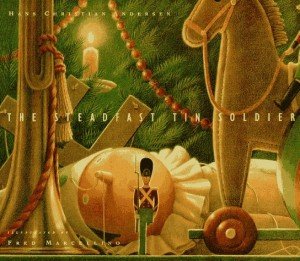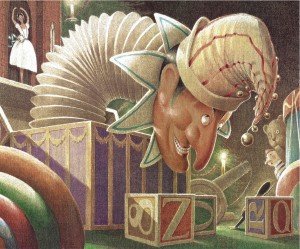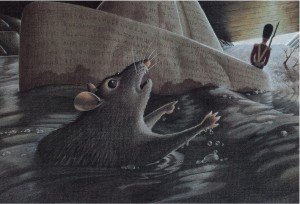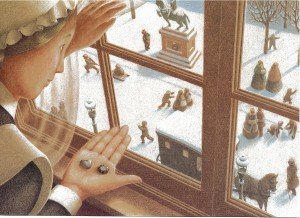 You’ve got to hand it to the old fairy tales~they always go for the gut-wrench. Or perhaps it’s a Hans Christian Andersen thing, or maybe even a Danish thing (without the delicious fruity filling.) In Andersen’s The Little Matchgirl, a poor waif freezes to death on New Year’s Eve while selling matches for her abusive father. In The Red Shoes, a haughty young girl is ‘rewarded’ with a pair of enchanted shoes that, as the Captain and Tennille song says, can’t stop dancing, even after the exhausted girl has chopped off her own feet. In 19th century children’s literature, behaviour had real consequences. No time-out chairs for that lot.
You’ve got to hand it to the old fairy tales~they always go for the gut-wrench. Or perhaps it’s a Hans Christian Andersen thing, or maybe even a Danish thing (without the delicious fruity filling.) In Andersen’s The Little Matchgirl, a poor waif freezes to death on New Year’s Eve while selling matches for her abusive father. In The Red Shoes, a haughty young girl is ‘rewarded’ with a pair of enchanted shoes that, as the Captain and Tennille song says, can’t stop dancing, even after the exhausted girl has chopped off her own feet. In 19th century children’s literature, behaviour had real consequences. No time-out chairs for that lot.
The Steadfast Tin Soldier is lighter fare, for sure, especially as depicted by the great Fred Marcellino, but nevertheless an ill-fated destiny awaits these star-crossed lovers, one made of tin and the other, a ballerina, made of paper, and the effect is, well, gut-wrenching.
Good thing the pictures are so pretty.
On Christmas Day, a young boy opens a box of 25 tin soldiers, all of whom are brothers, having been made from the same spoon. The last soldier is missing a leg. (Not quite enough spoon, apparently.) He stands at attention, refusing to shirk his duties or flout decorum in any way in spite of his infirmity. The steadfast soldier and his brothers are but 25 of the many presents the children have opened, the most splendid of which is a cardboard castle. In the doorway of the castle is a paper ballerina, dressed in white gauze with a blue sash pinned to her dress with a shiny spangle. On pointe, the ballerina’s leg is lifted so high behind her it appears as if she too is standing on one leg. The tin soldier is smitten, but thinks she is too grand, and would not abandon her castle to be an army wife, living in a box with 24 other soldiers. I don’t know…a bunch of young men in smartly tailored uniforms, all in want of a partner? Perhaps she’d give it a whirl, try it out, see how things go, but alas, she is never given the opportunity. You see, to be truly steadfast, self-denial will, by necessity, dictate your every every action. A steadfast tin soldier must remain on task, until, of course, a kid places you on a windowsill, and a sudden wind sweeps you off your one foot and drops you on your head into the gutter.
The soldier’s inability to seek assistance from the pedestrians on the street leaves him vulnerable to the rain, and the local street urchins, who scoop him up and send the tin solider on a race down to the canal in a paper boat. He encounters a large water rat, who demands a toll, but the current is too swift to stop, and the soldier is hurled over the edge of the pier and into the canal. “Yet even then, the tin solider remained at attention. No one could ever accuse him of flinching, not for a single second.” (The scene in the gutter is one of the best illustrations in the book, but then, I am very fond of rat drawings, especially those by Fred Marcellino.) As his harrowing journey continues, the boat sinks, and the solider is swallowed by a large fish, who is promptly caught by a fisherman. Next stop, the kitchen of the house where the soldier was originally stationed, at the end of the cook’s knife. The tin soldier is momentarily revered for his journey in the belly of a fish, and then forgotten. It is at this point that he sees his ballerina, still perched on one foot, still ‘steadfast’ in her gaze. “The tin soldier was so touched that he would have shed tin tears-if he hadn’t been in uniform.’ Steadfast, or repressed? Geez…
Soldiers will be soldiers and unfortunately, boys will be boys, as ‘for no apparent reason’, one of the boys unceremoniously picks up the worn and faded tin soldier and throws him into the hearth. A door opens, and a gust of wind blows the paper ballerina straight into the fire, by the soldier’s side. The next day, the housekeeper finds the tin soldier, melted into the shape of the heart beside the blackened spangle from the dancer’s sash. Tragic, really, but bittersweet, even relatable, minus the tin. The longing for love and the ache for the unattainable. The passive acceptance of the indignities of life. Our sometimes steadfast inability to get beyond our training, emotional and otherwise. Gut-wrenching. And very much drawn from the life of Hans Christian Andersen.
In The Steadfast Tin Soldier, Marcellino’s beautiful coloured pencil illustrations bring a lightness and humour to this otherwise sombre tale, but in all sorts of subtle ways, they also manage to capture the poignancy of the story. When Marcellino pulls back the perspective, and we see how tiny the ballerina and the soldier really are in relation to the present-strewn parlour, it amplifies their absolute vulnerability, and the insurmountable odds of their love ever reaching consummation (in a fairy tale way.) Embued with the shadowy light of candles and the opulent shimmer of Christmas decorations, Marcellino’s airy illustrations elevate the tone while at the same time act as a kind of contrast to the soldier’s restrictive steadfastness. And then there are the eyeballs.
When I think of Fred Marcellino, I think of rodents and cats, but in an illustrative way, as in those found in The Wainscott Weasel, and his Caldecott Honor book, Puss in Boots. Among his many skills, Marcellino had a very distinctive way with eyeballs, protruding them slightly out of the socket, resulting in a kind of delightful juiciness. He changed the way I, and others, illustrate eyeballs, although no one comes close to the expressiveness of his orbs, and indeed, his entire body of work.
Fred Marcellino (1939-2001) was a highly influential book cover designer (Unbearable Lightness of Being, Bonfire of the Vanities, The Handmaid’s Tale, etc.,) who came to children’s illustration later in his short life. Upon the publication of his first kid’s book, A Rat’s Tale, he said,
“Each picture is a link in a chain, and they all exist in counterpoint with the text. And although you want each picture to have impact, just like a jacket, the book illustration can also be much more subtle. It can be pondered and savored over a period of time. It’s a very different discipline from what I was used to, but I must say it was love at first sight.”
After he passed away from cancer, The Norman Rockwell held a retrospective of his work in 2003.
 Hans Christian Andersen (1805-1875) was a dorky, depressive, socially and sexually inept, sporadically employed actor from Odense, Denmark who was encouraged to become a poet and writer by his fellow thespians. In spite of the thinly veiled criticism of his acting chops, it was, and I think we can all agree on this, some pretty good advice on their parts, and fortuitous that Andersen heeded their words. Aligning himself with the unfortunate and the outcast, Andersen proceeded to write some of the most well-known, and emotionally stirring children’s stories of all time. Following in the footsteps of the Arabian Nights and the Brothers Grimm, Hans Christian Andersen became known as the father of the modern fairytale, and perhaps, the modern tear-jerker. Sending your kids out to sell matchsticks on New Year’s Eve would never be the same.
Hans Christian Andersen (1805-1875) was a dorky, depressive, socially and sexually inept, sporadically employed actor from Odense, Denmark who was encouraged to become a poet and writer by his fellow thespians. In spite of the thinly veiled criticism of his acting chops, it was, and I think we can all agree on this, some pretty good advice on their parts, and fortuitous that Andersen heeded their words. Aligning himself with the unfortunate and the outcast, Andersen proceeded to write some of the most well-known, and emotionally stirring children’s stories of all time. Following in the footsteps of the Arabian Nights and the Brothers Grimm, Hans Christian Andersen became known as the father of the modern fairytale, and perhaps, the modern tear-jerker. Sending your kids out to sell matchsticks on New Year’s Eve would never be the same.
The Steadfast Tin Soldier by Hans Christian Andersen, originally published in 1838. This edition, retold by Tor Seidler, with illustrations by Fred Marcellino, was published in 1992 by HarperCollins.





I’ve not heard of Fred Marcellino, but I love the examples of his work you’ve included here. There’s nothing by him in our library system though 🙁 I guess I’ll have to add him to my wishlist.